Archive for the ‘Ancient Egypt’ Category
By: The Scribe on June, 2007
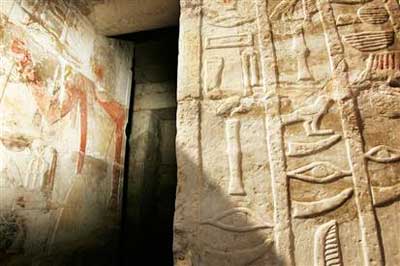
It appears that ancient Egypt did more than just worry about their hair and clothes… they also had a serious concern about their teeth! Archaeologists working at the site of ancient Saqqara discovered a tomb that was dedicated to three royal dentists over 4,200 years ago.
The dentists’ tombs are constructed out of limestone and mud brick, and each have a series of elaborately carved hieroglyphs and paintings. The tomb of the chief dentist has an inscription actually identifying his name – “Iy Mry” – as well as images depicting himself and his family carrying out ritual sacrifices, playing games together, and making offerings to the dead. A protective curse inscription above the tomb’s entrance reads: “Anyone who enters my tomb will be eaten by a crocodile and a snake.”
The tombs were identifiable as those of dentists’ due to the use of two hieroglyphs above the names of all three men, showing an eye above a tusk. The location of their burial next to the Step Pyramid would have been a place of honor for them, suggesting their practice was given a great deal of respect by the ancient Pharaohs.

The two other dentists, buried in separate tombs next to the chief dentist, also have their names spelled out in hieroglyphs: Kem Msw and Sekhem Ka. They must have all worked together during their lifetimes, which would explain why all three tombs were so close to one another.
According to ancient Egyptian medical papyri, there were actually two classes of dentists in ancient Egypt, the iryw-ibew – literally, “dentists” – which was the lower class of dentists, while the high-class dentists were known as the ir-iryw-ibew, which translates as “great of those who are concerned with teeth”. It is possible that the lower class dentists functioned much like dental hygienists in modern dentistry – there are even surviving descriptions of how to make ancient fillings and cure bad breath!
One ancient Egyptian ‘breath sweetener’ recipe reads as follows:
“Take frankincense, myrrh, cinnamon, bark and other fragrant plants, boil with honey and shape into pellets.”
…sounds like the ancient Egyptians had their own Tic-Tacs…
Want to read more?


Tomorrow: World’s oldest bugs (yes they are still icky)

By: The Scribe on May, 2007

Built in the 3rd century BC on the island of Pharos in Alexandria, Egypt, the Pharos of Alexandria was constructed initially as a landmark to help guide ships into the flat, harbor coastline of the city. The island was connected to the mainland through a man-made landbridge called the Heptastadion, which formed one side of the harbor, and it was only later in the 1st century AD that reflective mirrors and fire were added for its use as a lighthouse.
The Pharos’ construction was initiated by Ptolemy Soter around 290 BC, but was completed during the reign of his son, Ptolemy Philadelphus. The architect for the project was a man named Sostratus, who worked on his calculations and drawings at the Library of Alexandria.
Dedicated to the “savior gods” Ptolemy Soter and his wife Berenice, the Lighthouse gained such notoriety that it was later depicted on Roman coins that were circulated around the entire empire. Its outer layer was constructed of marble slabs, while the inner mirror was reputed to reflect light that could be seen up to 50km away! Another legend also stated that the mirror could be used to detect and burn enemy ships before they reached the shore, however this should simply be taken for what it is: a legend.
Several earthquakes in 1303 and 1323 caused significant damage to the structure of the lighthouse, and by 1349, the doorway was completely inaccessible. However, the Pharos was the last of the Seven Ancient Wonders to survive, and thus we have accurate knowledge of its exact location and outer appearance. Even today, remains from the Pharos stand reused as portions of the walls for a medieval fort built in 1480 AD, known as Fort Qaitby – constructed on the exact spot where the Lighthouse once stood.
Tomorrow: A gladiator graveyard?

By: The Scribe on May, 2007
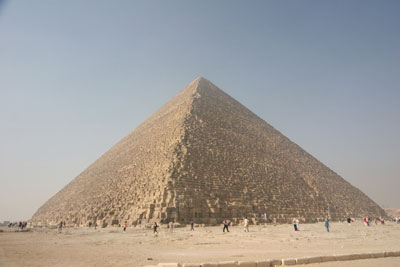
The oldest of the three pyramids at Giza, the Great Pyramid is the oldest and the only remaining monument of the Seven Wonders of the Ancient World. Constructed over what is believed to have been 20 years, the Great Pyramid was built as a resting place for the Pharaoh Khufu after his death.
Additional structures were built around the pyramid as part of a mortuary complex for the Pharaoh’s entire household, including several smaller pyramids, several temples, and a causeway leading down to the Nile. Near the complex was a small town for the workers, which included such facilities as a beer factory, bakeries, and metal-working production centers. Evidently, the Pharaoh spared no expense in ensuring his afterlife was as well-equipped as conceivably possible.
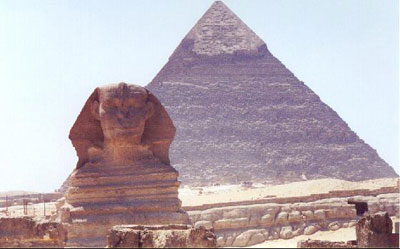
Recent evidence concerning the Great Pyramid’s construction suggests that previous assertions claiming the pyramid was built by slave labor are wrong. Instead, the workforce was paid, and would have included skilled craftsmen and an administrative body to ensure the project ran smoothly.
It is estimated that approximately 2 million blocks of stone, each weighing over 2 tons, were used to build the pyramid. The blocks were made of limestone, basalt and granite, with the outer casing consisting of white, highly polished, limestone slabs. The monument would have been extremely bright in the desert sun, however only several of these casing stones remain on the Great Pyramid today.
The inside of the pyramid consists of a large network of passages and chambers, and although the passages themselves were not carved with relief, a significant amount of graffiti was left behind on many of the blocks by the workers! The main burial chamber also has two small passages dubbed “air shafts” that ascend out of the Pyramid and are aimed directly at two stars in the Orion constellation; it is believed that these were intended as air shafts for the Pharaoh’s spirit to escape its entombment.
Want to read more?


Tomorrow: The Hanging Gardens

By: The Scribe on May, 2007
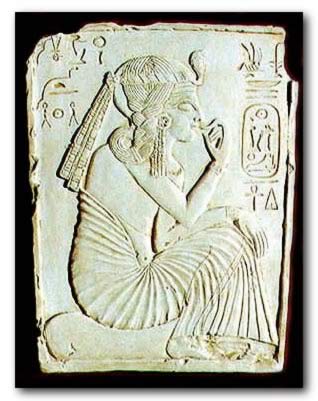 Like many people today, the ancient Egyptians were extremely concerned about outward appearance – and in particular, about their hair. From simple styling to elaborate wigs, most Egyptians spared no expense to ensure that their hair was perfect.
Like many people today, the ancient Egyptians were extremely concerned about outward appearance – and in particular, about their hair. From simple styling to elaborate wigs, most Egyptians spared no expense to ensure that their hair was perfect.
In order to avoid the problems of head lice, both Egyptian men and women often shaved their heads – this also made it far easier for a wig to sit on the head comfortably. Of course, not all people would do this, and there are tomb paintings and statues where an artist has actually shown little bits of a person’s natural hair peeking out from behind a wig! Priests were required to shave their heads and bodies of all hair – and would do so about every three days – in order to remain ritually clean.
In most cases, it appears that men’s wigs were actually more elaborate than those of women, who typically used wigs or hair extensions to make their natural hair more luxurious, or to fill out their own hair as it began to thin with age. In order to look more natural on the head, Egyptian wigs and extensions were almost always made with human hair, either bought or traded at the market, or from the shaved locks of the wearer.
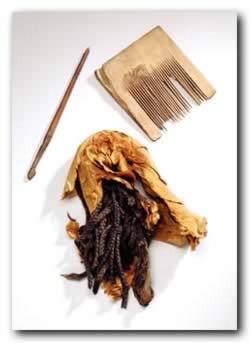
False braids and curls were among the most popular hairstyles of ancient Egypt, and both wigs and extensions could be attached right to the wearer’s own hair with various knots or weaves; for those who had shaved their heads, a small amount of beeswax and resin would be applied onto the scalp to hold the wig in place. To gain fullness in the hair, as seen in Egyptian wall paintings, the wigs often had an internal layer of padding, made of date-palm or other vegetable fibers.

The ancient Egyptians, it seems, had such an adversity to grey hair, that they would even dye the hair of corpses after death. Using vegetable henna, the hair would be dyed a dark brown or auburn color; in some cases, the dead were even provided with an extra set of hair extensions in their grave – just in case they needed their hair done in the afterlife.
Want to read more?


Tomorrow: Faces of Boa

Previous page | Next page







 Like many people today, the ancient Egyptians were extremely concerned about outward appearance – and in particular, about their hair. From simple styling to
Like many people today, the ancient Egyptians were extremely concerned about outward appearance – and in particular, about their hair. From simple styling to 


